
The Via Istrum was a Roman road and led from Belgrade along the lower Danube to the mouth of the Black Sea and met the Via Pontica.
background
The Via Istrum connected the Roman communication routes Via Militaris near Belgrade with the Via Pontica in the Danube Delta. It was a ship or land route along the Danube as part of the route from Rome to Byzantium (Istanbul).
The route is now of tourist interest as part of a Balkans- Round tripthat along the old Roman roads leads to some of the most interesting places and landscapes in the Balkans, combining history and tourism. One follows the Via Militaris to Belgrade and from there the Via Istrum the Danube along to ans Black Sea. From here the Via Pontica south direction Istanbul. From there you can either return across the Balkans along the Via Militaris, or along the Via Egnatia above Greece.
Via Istrum is identical to the section in many areas Belgrade Black Sea from Danube cycle path .
preparation
Because of the many border crossings, it is important to find out about customs and traffic regulations in advance if you are traveling with your own vehicle. A few basic knowledge of the Cyrillic script makes a lot of things easier on site, since not all signs are always available in Latin script, especially away from the main roads.
getting there
- Car: Anyone who travels with their own car or mobile home can do the old one Via Militaris follow from the north to Belgrade.
- flight: Belgrade Airport is an international airport with good connections.
- ship: The waterway along the Via Istrum is part of many Danube cruises,
Drive / let's go / ...

Serbia
- 1 Sremska Mitrovica (Сремска Митровица). Roman: Sirmium. It was conquered by the Romans in AD 14 and developed into an important transport hub and economic center during Roman rule, especially because of its favorable geographical location. Ten Roman emperors were born in and around the city. The ancient period ends with the conquest of Sirmium by the Avars in 582 and is also an important turning point in the history of Southeast Europe, as the Slavic conquest took place with the Avars. Today you can see the remains of a Roman imperial palace in a museum in the town center, which is well worth seeing. The area is well worth a visit Bač fortress.
- 2 Belgrade
 (Београд). Roman: Singidunum. In the 1st century BC The Romans conquered the areas up to the Danube. In addition to Sirmium (Sremska Mitrovica) and Viminatium (Stari Kostolac), Singidunum was an important strategic point on the Via Militaris and the Danubian Limes. When Legio IV. Flavia Felix was relocated to Singidunum in AD 86 to strengthen the imperial borders, the Roman city experienced its heyday, which gained in importance through the appointment of Emperor Hadrian as a Municipium and later also in the rank of a Colonia through the settlement of veterans . Today the Serbian metropolis with its many sights is a worthwhile travel destination.
(Београд). Roman: Singidunum. In the 1st century BC The Romans conquered the areas up to the Danube. In addition to Sirmium (Sremska Mitrovica) and Viminatium (Stari Kostolac), Singidunum was an important strategic point on the Via Militaris and the Danubian Limes. When Legio IV. Flavia Felix was relocated to Singidunum in AD 86 to strengthen the imperial borders, the Roman city experienced its heyday, which gained in importance through the appointment of Emperor Hadrian as a Municipium and later also in the rank of a Colonia through the settlement of veterans . Today the Serbian metropolis with its many sights is a worthwhile travel destination. - 3 Kostolac (Костолац). Roman: Viminatium. Also known as Stari Kostolac or sometimes as "Pompeii of Serbia", the place was an important ancient border town of the Roman province of Moesia between the 1st and 6th centuries and the headquarters of the Roman Legio VII Claudia. An interesting archaeological site and a partially reconstructed building from Roman times east of the city are well worth a visit. Also worth seeing Ram fortress, the Golubac fortress a few km east and the Smederevo fortress a little west of Kostolac.
- 5 Golubac (Голубац). Roman: Cuppae. It was a Roman fortress during the Roman and Early Byzantine Periods (1-6th centuries) and became a city (Columbria) in 554/5 AD. The place is a small port town with an impressive fortress. Beginning of the Đerdap National Park, the largest river cliff landscape in Europe.
Bulgaria.png/40px-Flag_of_Bulgaria_(bordered).png)

Bulgaria was a hub because of its location Roman roads. Since the Danube represents the state border with Romania for a long distance, you will find interesting tourist places on both sides (see Danube), so that you have to cross the respective national borders from time to time, you want to see the sights on both sides of the river.
- 6 Vidin
 (Видин). Roman: Bononia. It was an important city in the Roman province of Moesia (Moesia). The landmarks of Vidin are the castle of Baba Vida, the only completely preserved medieval castle in Bulgaria, the Vidin Synagogue, the Church of St. Petka, the mosque and the library of Osman Pazvantoglu.
(Видин). Roman: Bononia. It was an important city in the Roman province of Moesia (Moesia). The landmarks of Vidin are the castle of Baba Vida, the only completely preserved medieval castle in Bulgaria, the Vidin Synagogue, the Church of St. Petka, the mosque and the library of Osman Pazvantoglu.
- 7 Ratiaria. Roman: Ratiaria or Colonia Ulpia Traiana Ratiaria. The fort was part of the fortress chain of the Danube Limes. The ruins of the ancient site are now two kilometers west of the village of Artschar. In ancient times, Ratiaria was located at a crossing over the Danube, where two important roads crossed, on the one hand the Via Istrum along the Danube and on the other the road from Lezha (Albania), on the Adriatic, via Ulpiana (Kosovo) and Niš (Serbia) coming. Today you can see ruins in a somewhat overgrown excavation site.
- 8 Lom (Лом). Roman: Almus. It consisted of a fort and a way station and belonged to the administrative area of the ancient Roman city of Ratiaria. Today Lom has the second largest Bulgarian port on the Danube. The foundation walls of the ancient fortress Almus, the historical museum, the Borunska church and the remains of the Asparuch wall are worth seeing. There is also a 500 m long pebble beach on the Danube.
- 9 Gigs. Roman: Colonia Ulpia Oescus, had a Roman fort near the village. The extensive ruins are in the northwestern part of the village. A bridge built or rebuilt by Constantine I, which was named in his honor, Constantine Bridge, connected Oescus with Sucidava (today's Corabia) across the Danube in the 4th century.
- 10 Swishtov (Свиштов). Roman: Novae. In the beginning only a Roman fortress of the Danube Limes. A fortress stood here from the middle of the 1st century AD. Today a place without any particular sights.
- 11 Ruse,
 (Русе). Roman Sexaginta Prista. The Romans founded the port city of Sexaginta Prista (city of 60 ships) there at the beginning of the 2nd century AD. It was the base of the Danube fleet of the Romans, which had the task of protecting the northern border of the Roman Empire against attacks by the peoples north of the Danube. The city is mentioned until the 5th century, when the Roman name was changed to Pristis and later Pristapolis. It can be assumed that the fall of the Roman city is related to the invasions of the Avars and Slavs in 586. Today the city has a small port for cruise ships. There is a historical, a natural science and a transport museum as well as an art gallery. Many buildings are from the Baroque and Renaissance periods, which makes the place worth seeing.
(Русе). Roman Sexaginta Prista. The Romans founded the port city of Sexaginta Prista (city of 60 ships) there at the beginning of the 2nd century AD. It was the base of the Danube fleet of the Romans, which had the task of protecting the northern border of the Roman Empire against attacks by the peoples north of the Danube. The city is mentioned until the 5th century, when the Roman name was changed to Pristis and later Pristapolis. It can be assumed that the fall of the Roman city is related to the invasions of the Avars and Slavs in 586. Today the city has a small port for cruise ships. There is a historical, a natural science and a transport museum as well as an art gallery. Many buildings are from the Baroque and Renaissance periods, which makes the place worth seeing.
- 12 Ryahovo. Roman: Appiaria. The village was laid out under Emperor Vespasian as a fortress on the bank of the Danube, which was probably destroyed by Bulgarian invaders in the 7th century. Today a place with no interesting sights.
- 13 Tutrakan (Тутракан). Roman: Transmarisca. Around 40-50 AD until the end of the 3rd century AD there was a permanent Roman military post here on the Limes Moesiae, the Roman fortification system in the lower Danube region. During the reigns of the Roman Emperors Vespasian (69-98 AD) and Trajan (98-117 AD) fortifications were built and expanded, known as the Transmarisca Fortress. The late antique Transmarisca fortress existed as an early Byzantine post until the beginning of the 7th century. It was then taken over, used and expanded by the First Bulgarian Empire (632 / 680-1018 AD). Archaeological excavations have uncovered part of the northern fortress wall, a castle with two rectangular towers and part of the southern wall. The fortress is still being excavated. Otherwise the place offers little of tourist interest.
- 14 Silistra
 (Силистра). Roman Dorostorum. Silistra was founded by the Romans in 29 AD and was an important military base, river port and road station in the province of Moesia on the Danube Limes. From here the route branches either towards Romania, Ukraine or across Marcianopolis (Dewnja) and Varna to Via Pontica Direction Istanbul. A Roman tomb, which was only discovered in 1942, is worth seeing. More Roman ruins can be found scattered throughout the city. Outside the city is the Medjid Tabija fort, built in the mid-19th century.
(Силистра). Roman Dorostorum. Silistra was founded by the Romans in 29 AD and was an important military base, river port and road station in the province of Moesia on the Danube Limes. From here the route branches either towards Romania, Ukraine or across Marcianopolis (Dewnja) and Varna to Via Pontica Direction Istanbul. A Roman tomb, which was only discovered in 1942, is worth seeing. More Roman ruins can be found scattered throughout the city. Outside the city is the Medjid Tabija fort, built in the mid-19th century.
Romania
- 15 Isaccea (Исакча). Roman: Noviodunum ad Istrum. The Roman Empire took control of the city, which became part of the province of Moesia, in AD 46. Noviodunum - which is 2 km east of the present city - was fortified and became the main military and economic center of the region. Here was the base of the Roman Navy on the lower Danube, only a few remains can be visited today. Otherwise the place offers little tourist.
- 16 Tulcea
 (Тулча). Roman: Toesmis. Tulcea has been an important port city since ancient times. After its conquest by the Romans in the first century, it was the base of the Roman Northeast Fleet. The Roman Legion I Iovia Scythica was stationed there with a unit and guarded the border with the Barbaricum as Legio ripariensis ("Shore Legion") on the Danube. Tulcea is still an important port city, is also the base of the Romanian river navy and is considered the gateway to the Danube Delta, which is a protected natural world heritage site.
(Тулча). Roman: Toesmis. Tulcea has been an important port city since ancient times. After its conquest by the Romans in the first century, it was the base of the Roman Northeast Fleet. The Roman Legion I Iovia Scythica was stationed there with a unit and guarded the border with the Barbaricum as Legio ripariensis ("Shore Legion") on the Danube. Tulcea is still an important port city, is also the base of the Romanian river navy and is considered the gateway to the Danube Delta, which is a protected natural world heritage site.
security
see country articles: Serbia, Bulgaria, Romania
trips
_2.JPG/500px-Bač_fortress_(Bačka_tvrđava)_2.JPG)
Serbia
- 1 Bač fortress (Бачка тврђава). The medieval fortress is quite well preserved and definitely worth a visit.
- 2 Smederevo fortress (Смедеревска тврђава). It is a medieval fortress town in Smederevo, which was temporarily the capital of Serbia in the Middle Ages. It was built between 1427 and 1430 and further fortified by the Ottoman Empire, which captured the city in 1459. The fortress survived several sieges by Ottomans and Serbs and remained relatively unscathed. Unfortunately, it was badly damaged by bombs during World War II. Extensive restoration and conservation work began in 2009. Despite the damage, the fortress is one of the rarely preserved courts of medieval Serbian rulers.
- 3 Ram fortress (Тврђава Рам). The remarkable Ram fortress from the 15th century is located on a steep slope on the right bank of the Danube in the village of Ram and is in good condition.
- 4 Lepenski Vir (Лепенски Вир). is a Middle and Neolithic archaeological site on the territory of the Serbian community Majdanpek at the Iron Gate on the Danube. The first traces of settlement date from around 7000 BC. The settlement reached its peak between 5300 and 4800 BC. Chr.
- 5 Manasija Monastery (Манастир Манасија). Very nice, quiet place in the middle of green hills. The monastery is surrounded by the magnificent towers of the medieval fortress.
- 6 Ravanica Monastery (Манастир Раваница). The monastery complex is well worth seeing.
- 7 Tabula Traiana (Трајанова табла). (Table of Traian) is an inscription dedicated to the Roman emperor Trajan, which was carved into the rock of the Iron Gate.
- 8 Lederata (Ледерата). was a Roman castle built at the end of the 1st century AD. Some of his remains are on a rocky plateau just outside of Rama.
- 9 Đerdap National Park (Национални парк Ђердап). Wonderful nature, many hiking trails, wonderful views of mountains around. Perfect for sightseeing and hiking.
- 11 Diana fortress (Тврђава Диана). The fortress is a Roman fortress from AD 100-101 in Kladovo. The remains can be viewed in a slightly overgrown condition.
Bulgaria

- 12 Magura cave (Пећина Магура). The cave was first used by humans between 50,000 and at least 36,000 BP, and it must have been Neanderthals. Paintings can be seen on some walls, the oldest of which date from the Upper Palaeolithic, but mainly depictions from the Neolithic, Copper and Bronze Ages. A special feature is the oldest European solar calendar from the late Aeolithic or the late Neolithic with 366 days. In contrast to most caves, in Magura not only inorganic substances were used for the paintings, but also organic, namely fossilized bat guano.
- 14 Belogradchik Castle & Rocks (Тврђава Белоградчик). It is an old fortress on the northern slopes of the Balkan Mountains. It is one of the main cultural and historical tourist attractions in the area. It is one of the best preserved strongholds in Bulgaria and a cultural monument of national importance.
- 15 Nicopolis ad Istrum. During the reign of Emperor Trajan (98–117), the city was founded after the victory over the Draker and was important for centuries. The excavation site, which is worth seeing, has only been partially uncovered.
- 16 Veliko Tarnovo
 (Велико Трново). The place was fortified during Roman times (1st to 6th century AD). Veliko Tarnowo is also a preferred tourist destination because of its special location on the rocky steep bank and in the hinterland of the Jantra River, because of the historical traditions and architectural monuments.
(Велико Трново). The place was fortified during Roman times (1st to 6th century AD). Veliko Tarnowo is also a preferred tourist destination because of its special location on the rocky steep bank and in the hinterland of the Jantra River, because of the historical traditions and architectural monuments.
- 17 St. Dimitar Basarabowski Rock Monastery (Basarbowski Monastery). Worth seeing rock monastery near Ruse.
- 18 Ivanovo rock churches (Камене цркве у Иванову). The central monastery church, in which the most important frescoes are located, is dedicated to the Virgin Mary and is also simply called Zarkwata (Bulgarian "The Church"). It was carved into the rock at a height of 38 m above the road and consists of a naos, a narthex and an adjoining chapel.

- 19 Abrittus. Ruins of a Roman city. It was a Roman fort and a civil settlement (vicus) or early Byzantine city. The fort is one of the best-researched Roman sites in Southeast Europe. It was the first time that a Roman fortification was almost completely excavated and preserved in Bulgaria.
- 20 Thracian tomb of Sveshtari (Трачка гробница у Свештарију). The Thracian tomb of Sveshtari has been a UNESCO World Heritage Site since 1985. Grave from the 3rd century BC Chr.

- 21 Demir Baba Teke (Demir-Baba-Tekke). The Demir-Baba-Tekke is an Alian mausoleum from the 16th century near the village of Svehtari and is part of the historical and archaeological site of Sborjanowo.
Romania
- 22 Statue of Decebalus (Децебал (скулптура)). The statue of the Dacer king Decebalus is a 55 meter high statue and at the same time the highest rock sculpture in Europe.
- 23 Trajan's Bridge (Трајанов мост), Str. Independen Strei 2, în curtea Muzeului Regiunii “Porților de Fier”, municipiul Drobeta Turnu Severin. The Trajan's Bridge was the first permanent bridge over the lower Danube. Although it was destroyed after around 165 years, it remained the longest built bridge in the world for over a millennium, both in terms of its total length and its arch spans. The foundations and parts of the bridge arches can still be seen.


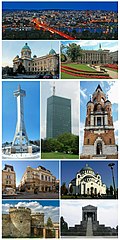



.jpg/500px-Belgrad,_fortress_-_panoramio_(6).jpg)





.jpg/500px-Central_square_of_Lom_-_panoramio_(2).jpg)













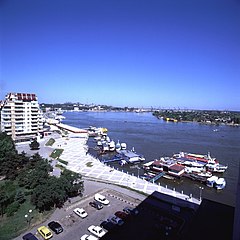



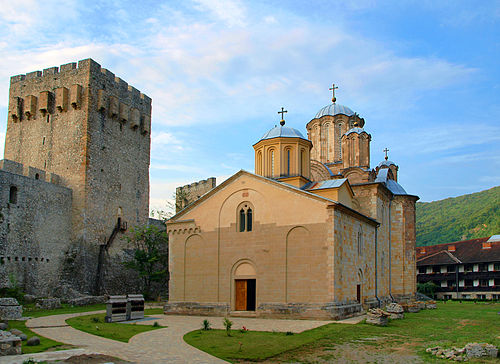






_-_Castra_Martis.JPG/500px-Kula_(Кула)_-_Castra_Martis.JPG)








.jpg/500px-Razgrad_Region_-_Isperih_Municipality_-_Village_of_Malak_Porovets_-_Village_of_Sveshtari_-_Demir_Baba_Tekkesi_(14).jpg)

.jpg/300px-Piciorul_Podului_lui_Traian,_malul_românesc_(19_august_2009).jpg)



.JPG/350px-Lepenski_Vir_(2).JPG)

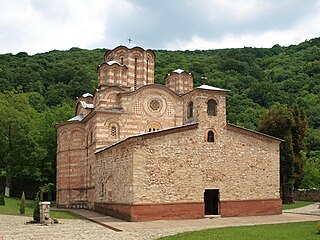




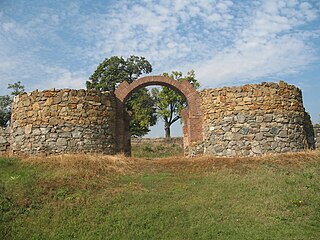
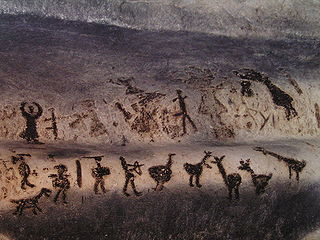
_-_Castra_Martis.JPG/350px-Kula_(Кула)_-_Castra_Martis.JPG)


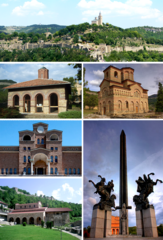



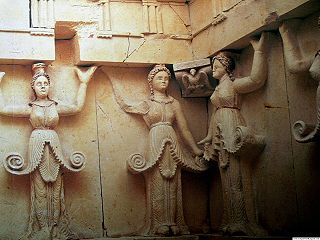
.jpg/350px-Rock_Sculpture_of_Decebalus_(26845769043).jpg)
.jpg/180px-Piciorul_Podului_lui_Traian,_malul_românesc_(19_august_2009).jpg)